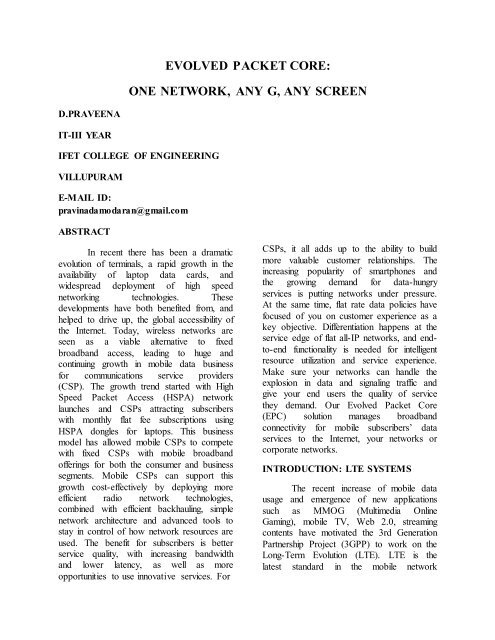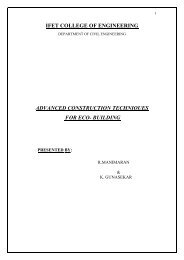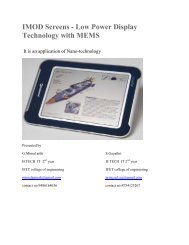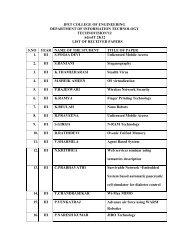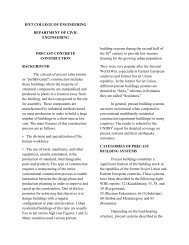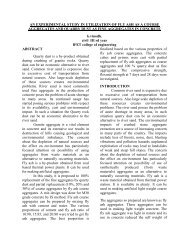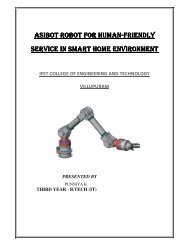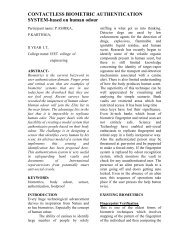evolved packet core - IFET College of Engineering
evolved packet core - IFET College of Engineering
evolved packet core - IFET College of Engineering
You also want an ePaper? Increase the reach of your titles
YUMPU automatically turns print PDFs into web optimized ePapers that Google loves.
EVOLVED PACKET CORE:<br />
ONE NETWORK, ANY G, ANY SCREEN<br />
D.PRAVEENA<br />
IT-III YEAR<br />
<strong>IFET</strong> COLLEGE OF ENGINEERING<br />
VILLUPURAM<br />
E-MAIL ID:<br />
pravinadamodaran@gmail.com<br />
ABSTRACT<br />
In recent there has been a dramatic<br />
evolution <strong>of</strong> terminals, a rapid growth in the<br />
availability <strong>of</strong> laptop data cards, and<br />
widespread deployment <strong>of</strong> high speed<br />
networking technologies. These<br />
developments have both benefited from, and<br />
helped to drive up, the global accessibility <strong>of</strong><br />
the Internet. Today, wireless networks are<br />
seen as a viable alternative to fixed<br />
broadband access, leading to huge and<br />
continuing growth in mobile data business<br />
for communications service providers<br />
(CSP). The growth trend started with High<br />
Speed Packet Access (HSPA) network<br />
launches and CSPs attracting subscribers<br />
with monthly flat fee subscriptions using<br />
HSPA dongles for laptops. This business<br />
model has allowed mobile CSPs to compete<br />
with fixed CSPs with mobile broadband<br />
<strong>of</strong>ferings for both the consumer and business<br />
segments. Mobile CSPs can support this<br />
growth cost-effectively by deploying more<br />
efficient radio network technologies,<br />
combined with efficient backhauling, simple<br />
network architecture and advanced tools to<br />
stay in control <strong>of</strong> how network resources are<br />
used. The benefit for subscribers is better<br />
service quality, with increasing bandwidth<br />
and lower latency, as well as more<br />
opportunities to use innovative services. For<br />
CSPs, it all adds up to the ability to build<br />
more valuable customer relationships. The<br />
increasing popularity <strong>of</strong> smartphones and<br />
the growing demand for data-hungry<br />
services is putting networks under pressure.<br />
At the same time, flat rate data policies have<br />
focused <strong>of</strong> you on customer experience as a<br />
key objective. Differentiation happens at the<br />
service edge <strong>of</strong> flat all-IP networks, and endto-end<br />
functionality is needed for intelligent<br />
resource utilization and service experience.<br />
Make sure your networks can handle the<br />
explosion in data and signaling traffic and<br />
give your end users the quality <strong>of</strong> service<br />
they demand. Our Evolved Packet Core<br />
(EPC) solution manages broadband<br />
connectivity for mobile subscribers’ data<br />
services to the Internet, your networks or<br />
corporate networks.<br />
INTRODUCTION: LTE SYSTEMS<br />
The recent increase <strong>of</strong> mobile data<br />
usage and emergence <strong>of</strong> new applications<br />
such as MMOG (Multimedia Online<br />
Gaming), mobile TV, Web 2.0, streaming<br />
contents have motivated the 3rd Generation<br />
Partnership Project (3GPP) to work on the<br />
Long-Term Evolution (LTE). LTE is the<br />
latest standard in the mobile network
technology tree that previously realized the<br />
GSM/EDGE and UMTS/HSxPA network<br />
technologies that now account for over 85%<br />
<strong>of</strong> all mobile subscribers. LTE will ensure<br />
3GPP’s competitive edge over other cellular<br />
technologies. LTE, whose radio access is<br />
called Evolved UMTS Terrestrial Radio<br />
Access Network (E-UTRAN), is expected to<br />
substantially improve end-user throughputs,<br />
sector capacity and reduce user plane<br />
latency, bringing significantly improved<br />
user experience with full mobility. With the<br />
emergence <strong>of</strong> Internet Protocol (IP) as the<br />
protocol <strong>of</strong> choice for carrying all types <strong>of</strong><br />
traffic, LTE is scheduled to provide support<br />
for IP-based traffic with end-to-end Quality<br />
<strong>of</strong> service (QoS). Voice traffic will be<br />
supported mainly as Voice over IP (VoIP)<br />
enabling better integration with other<br />
multimedia services.<br />
ENABLING MIGRATIONS FROM<br />
CURRENT NETWORKS TO LTE<br />
3GPP R8 introduces major advances<br />
in mobile networks. For the subscriber, it<br />
means higher access rates and lower latency<br />
on the connection, while for the mobile<br />
CSP, Long Term Evolution (LTE) radio<br />
technology provides lower cost per<br />
transmitted bit thanks to more efficient use<br />
<strong>of</strong> radio network resources. The technology<br />
also <strong>of</strong>fers more flexibility in frequency<br />
allocation, thanks to the ability to operate<br />
LTE networks across a very wide spectrum<br />
<strong>of</strong> frequencies. LTE also minimizes the<br />
power consumption <strong>of</strong> terminals that are<br />
used ‘always-on’.<br />
always available for all subscribers. This<br />
allows fast access to services as well as<br />
network initiated services such as<br />
terminating voice calls and push e-mail. The<br />
connection setup time for person-to-person<br />
communication is also minimized with<br />
always-on bearers.<br />
Evolved Packet Core (EPC) was<br />
designed to support any mobile access<br />
technology including LTE, 2G/EDGE,<br />
3G/HSPA, <strong>evolved</strong> HSPA, CDMA, WiFi<br />
and WiMAX and as such serves as a<br />
common anchor point for subscribers<br />
moving between the different access<br />
networks. EPC’s ability to support both LTE<br />
as well as current access technologies gives<br />
CSPs a smooth migration path to LTE/SAE.<br />
As well as providing connectivity between<br />
the radio network and the content and<br />
service networks, EPC also acts as the<br />
policy and charging enforcement point. The<br />
mobile gateway is a central point through<br />
which all the traffic must travel, making it<br />
the natural place to enforce policy and<br />
charging rules. This centralized control<br />
allows the CSP to enforce preferred business<br />
models and stay in control <strong>of</strong> how network<br />
resources are used.<br />
CIRCUIT AND PACKET DOMAINS<br />
3GPP R8 also introduces major<br />
advances in the <strong>core</strong> network that improve<br />
service quality and networking efficiency,<br />
leading to a better end user experience.<br />
GPRS technology has already introduced the<br />
always-on concept for subscriber<br />
connectivity and 3GPP R8 mandates this<br />
ability, with at least one default bearer being
SAE<br />
System Architecture Evolution (aka<br />
SAE) is the <strong>core</strong> network architecture <strong>of</strong><br />
3GPP's LTE wireless communication<br />
standard. SAE is the evolution <strong>of</strong> the GPRS<br />
Core Network, with some differences:<br />
• simplified architecture<br />
• all-IP Network (AIPN)<br />
• support for higher throughput and<br />
lower latency radio access networks (RANs)<br />
• support for, and mobility between,<br />
multiple heterogeneous access networks,<br />
including E-UTRA (LTE and LTE<br />
Advanced air interface), 3GPP legacy<br />
systems (for example GERAN or UTRAN,<br />
air interfaces <strong>of</strong> GPRS and UMTS<br />
respectively), but also non-3GPP systems<br />
(for example WiMAX or cdma2000)<br />
THE DEMAND FOR COST-<br />
EFFECTIVE SUPPORT OF MOBILE<br />
DATA GROWTH<br />
With circuit switched services, the<br />
amount <strong>of</strong> traffic is directly proportional to<br />
CSP revenue. However, as developed<br />
markets have reached saturation, CSPs have<br />
been forced into fierce competition on voice<br />
call tariffs. The consequent fall in voice<br />
revenues has been compensated for by<br />
improving network efficiency with 3GPP<br />
release 4 MSC Server System, which is<br />
already leading to costeffective voice<br />
services.<br />
Mobile networks are experiencing a<br />
transformation from circuit switched<br />
to<strong>packet</strong> switched technology. Along with<br />
this development, the CSP business model is<br />
changing from a pure service provider to a<br />
service and connectivity provider. In circuit<br />
switched mobile networks, services are<br />
predominantly provided and controlled by<br />
the CSP. Internet access is revolutionizing<br />
this business model in <strong>packet</strong> switched<br />
networks, where the CSP provides<br />
connectivity and data transport. New<br />
methods are also needed to manage the<br />
growing volumes <strong>of</strong> data traffic.<br />
DRIVING DOWN THE COST PER<br />
TRANSMITTED BIT<br />
An important business challenge that<br />
mobile CSPs are facing is the ecoupling <strong>of</strong><br />
the association between traffic volume and<br />
revenues. With revenue growth not keeping<br />
pace with the growth in data volumes, the<br />
only way for CSPs to retain pr<strong>of</strong>itability is<br />
to lower the cost per transmitted bit. Even<br />
though most capital and operational<br />
expenditures are due to the radio and<br />
transmission networks, there is also room<br />
for optimization in the <strong>core</strong> network.<br />
Examples <strong>of</strong> improvements that can be<br />
introduced in today’s networks are<br />
deploying all-IP interfaces with the radio<br />
network and introducing Direct Tunnel in<br />
3G networks. Mobile CSPs are currently<br />
forced to maintain parallel networks for<br />
voice and data services and considerable<br />
savings are expected when all services can<br />
be <strong>of</strong>fered over a single, IP based network<br />
technology.<br />
ENABLING SERVICE EVOLUTION<br />
LTE/SAE is designed to support all<br />
CSP services, including data, high quality<br />
voice and multimedia. Current <strong>packet</strong><br />
switched mobile networks have been<br />
designed to accommodate user initiated<br />
communications. If services and<br />
applications are to enable facilities such as<br />
person-to-person communication, the<br />
network and terminals must support<br />
‘always-on’ sessions, allowing subscribers<br />
to be continuously reachable for incoming<br />
calls. Always-on sessions are also needed<br />
for machine-to-machine applications.
For the <strong>packet</strong> <strong>core</strong>, always-on<br />
sessions mean increasing demand for higher<br />
subscriber density. Together with the 3GPP<br />
R8 flat architecture, where all the mobility<br />
transactions are directly visible to the <strong>core</strong><br />
network, the signaling performance <strong>of</strong> the<br />
<strong>core</strong> network elements must also be<br />
carefully considered. Traffic patterns in<br />
mobile networks are evolving. The original<br />
assumption for mobile data services was that<br />
the CSP provides the services and access to<br />
corporate intranets. Currently, mobile data<br />
subscriptions, particularly HSPA, are mostly<br />
used for both open Internet access and<br />
company intranet access.<br />
STAYING IN CONTROL OF TRAFFIC<br />
GROWTH<br />
LTE radio technology will allow<br />
increasing amounts <strong>of</strong> traffic to be<br />
transmitted over the network, increasing the<br />
CSP’s need to stay in control <strong>of</strong> traffic.<br />
Better technology is allowing the<br />
development <strong>of</strong> new applications and<br />
services, many <strong>of</strong> which the CSP will need<br />
to treat differently to ensure users get the be<br />
possible service quality. Prioritized<br />
treatment is particularly important for<br />
premium services such as CSP VoIP and<br />
other high quality real-time services.<br />
In current 2G/3G and CDMA<br />
broadband networks, there is already an<br />
urgent need to deploy online usage control<br />
to service access. A typical example are fair<br />
usage policies that are applied to set limits to<br />
the maximum access speed that the<br />
subscriber is allowed to retrieve from the<br />
network and to limit the maximum amount<br />
<strong>of</strong> data consumed during the subscription<br />
period.<br />
STEPWISE MIGRATION TO 3GPP R8<br />
EPC<br />
The key functions <strong>of</strong> the Packet Core<br />
network are to support subscriber mobility,<br />
to provide connectivity between the radio<br />
access network and the service networks and<br />
to serve as a centralized control point to<br />
enforce CSP business policies. 3GPP R8<br />
allows CSPs to migrate from their existing<br />
Packet Core to EPC in smooth steps,<br />
ensuring the subscribers see no major<br />
disruptions as their network evolves.<br />
EPC INTRODUCTION WITH<br />
MINIMUM CHANGES TO THE<br />
EXISTING PRE-R8 PACKET CORE<br />
Deploying EPC as an overlay allows<br />
LTE to be introduced with minimum<br />
changes to the existing pre-R8 Packet Core.<br />
According to 3GPP R8, the P-GW supports<br />
in-built GGSN functionality including Gn<br />
interface support. The Gn interface can also<br />
be applied between 2G/3G SGSN and a<br />
stand-alone MME element to support<br />
handovers between 2G/3G networks and<br />
LTE. In handovers between the access<br />
technologies, EPS bearers are mapped 1:1 to<br />
2G/3G PDP contexts and vice versa.
As P-GW is the anchoring point for<br />
LTE subscribers, independently <strong>of</strong> which<br />
access network they use, connectivity must<br />
also be provided between 2G and 3G access<br />
networks and the P-GW.<br />
TOWARDS A FULLY INTEGRATED<br />
R8 NETWORK<br />
In the integrated scenario, all<br />
accesses including 2G/3G accesses use a<br />
common gateway, the 3GPP R8 S/P-GW.<br />
With Direct Tunnel and S4 interface, the 3G<br />
SGSN is very tightly aligned with Evolved<br />
Packet Core architecture and can provide<br />
synergies when deployed in the same<br />
physical network element as the MME.<br />
According to 3GPP specifications, the<br />
handling <strong>of</strong> user plane and control plane<br />
traffic is tightly coupled in 2G SGSN and<br />
Direct Tunnel type optimization is not<br />
possible. This limits the synergy benefits<br />
that can be attained by deploying 2G SGSN<br />
in the same physical node as the MME.<br />
Many CSPs may find it best to continue<br />
using their existing SGSN for 2G traffic<br />
handling.<br />
The common Gateway for 2G, 3G<br />
and LTE provides obvious synergies, yet the<br />
CSP may decide to upgrade existing GGSN<br />
to allow service access to LTE subscribers.<br />
In this scenario, low bandwidth services<br />
such as WAP browsing and MMS would<br />
remain in the existing GGSN, whereas high<br />
volume services such as Internet and<br />
corporate intranet access would be migrated<br />
to the S-GW/P-GW that also allows service<br />
access for 2G/3G subscribers.<br />
CONTINUOUS SUPPORT FOR<br />
SERVICES<br />
LTE/EPC is designed to support all<br />
services, including the CSP’s primary voice<br />
service. In order to achieve this, EPC<br />
bearers are always-on, allowing fast call<br />
setup and ensuring subscribers are always<br />
available for incoming calls. LTE radio<br />
interface provides more efficient radio usage<br />
for VoIP via maximized terminal battery<br />
lifetime and minimized latency. The flat<br />
architecture contributes to the optimized<br />
path for user plane traffic and minimal<br />
latency.<br />
ENSURING CONTINUITY FOR VOICE<br />
SERVICE<br />
Today, a CSP’s primary voice<br />
service is provided over the Circuit<br />
Switched network. Primary in this context<br />
refers to the voice service that the user gets<br />
when picking up a mobile phone and dialing<br />
a number. The CSP may <strong>of</strong>fer a secondary<br />
voice service comparable to Internet based<br />
VoIP services. In an early phase <strong>of</strong> LTE<br />
deployment, the most commonly available<br />
terminals will probably be data cards for<br />
laptops. For this kind <strong>of</strong> terminal, the<br />
secondary voice service is <strong>of</strong>fered with VoIP<br />
clients. When handheld LTE terminals<br />
become available, subscribers will expect<br />
the primary voice service to be available.<br />
The short to mid-term solution to provide<br />
CSP primary voice service to LTE<br />
subscribers is Circuit Switched Fall Back<br />
(CSFB), which is specified in 3GPP R8.<br />
In the CSFB scenario, the end user<br />
terminal is simultaneously attached to both<br />
the EPS (MME) and CS (MSC) domain.<br />
When the user initiates or receives a voice<br />
call, the UE is moved from LTE to the<br />
2G/3G CS network before the call is set up.<br />
The procedure is standardized in 3GPP R8.<br />
3GPP R8 EVOLVED PACKET CORE<br />
UNIFIES MOBILE NETWORKS<br />
Evolved Packet Core plays an<br />
essential role in unifying mobile networks,<br />
<strong>of</strong>fering interoperability between LTE and<br />
existing wireless access technologies. With<br />
these capabilities, it <strong>of</strong>fers smooth transition
to 3GPP R8 architecture and technology,<br />
independent <strong>of</strong> the access technologies<br />
currently deployed in CSP networks.<br />
EVOLVED PACKET SYSTEM TO<br />
CARRY ALL SERVICES<br />
3GPP R8 specifies Evolved Packet<br />
System (EPS) as a flat all-IP network<br />
architecture that is ready to carry all CSP<br />
services, from mobile broadband data to<br />
high quality voice and multimedia. EPC<br />
links the wireless access networks to the<br />
service and content networks. In this<br />
position, it is the natural point to enforce<br />
charging and traffic treatment policies to<br />
allow the CSP to stay in control <strong>of</strong> how<br />
network resources are used.<br />
Evolved Packet Core is required to<br />
support the LTE radio network, subscriber<br />
mobility and to <strong>of</strong>fer interoperability<br />
between LTE and other CSP access<br />
networks. Handovers between LTE and<br />
other networks must be supported and<br />
service continuity must be ensured. 3GPP<br />
R8 specifies optimized interworking<br />
between LTE and other 3GPP accesses and<br />
CDMA to minimize handover times.<br />
REFERENCES<br />
• SAE and the Evolved Packet<br />
Core - driving the mobile broadband<br />
revolution: "SAE and the Evolved Packet<br />
Core - driving the mobile broadband<br />
revolution". Elsevier.<br />
• LTE White Paper: "Long Term<br />
Evolution (LTE):A Technical Overview"<br />
(PDF). Motorola.<br />
• Strategic White Paper: "Introduction<br />
to Evolved Packet Core" (PDF). Alcatel-<br />
Lucent.<br />
• Technical White Paper: "Evolved<br />
Packet Core solution: Innovation in LTE<br />
<strong>core</strong>" (PDF). Alcatel-Lucent.<br />
• SAE test bed: "Nomor provides SAE<br />
(System Architecture Evolution) test bed<br />
within the SEA project". Nomor Research.<br />
DIMENSIONING AN EPC<br />
The key gateway dimensioning<br />
parameters are:<br />
• throughput in Gbit/s to support non-realtime<br />
services and <strong>packet</strong>s per second to<br />
support real-time services<br />
• number <strong>of</strong> subscribers to allow high<br />
subscriber density<br />
• number <strong>of</strong> transactions per second to<br />
support subscriber mobility All these<br />
dimensions must be supported<br />
simultaneously and must scale<br />
independently <strong>of</strong> each other.


